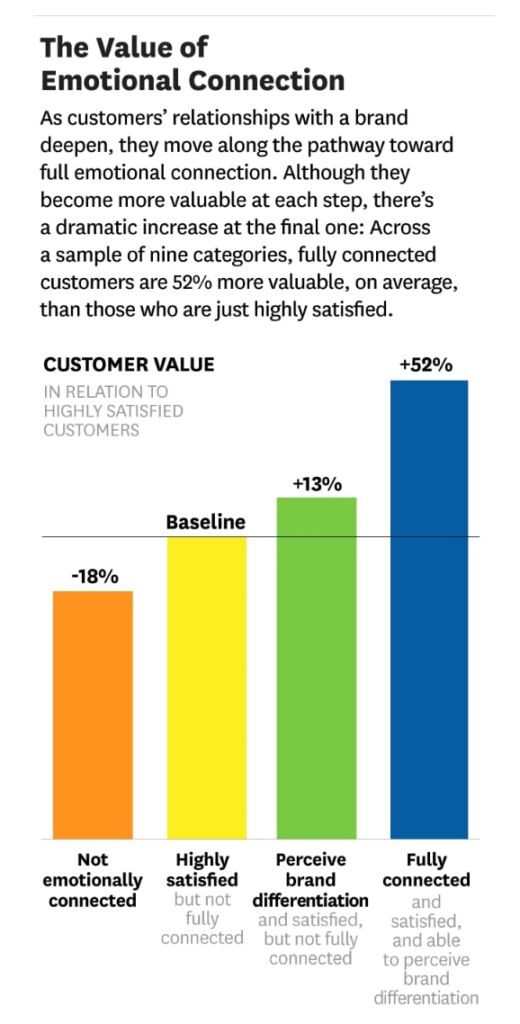It used to be that loyalty programs had a nice, easy formula. Customers earn points for their purchases and some of those points get redeemed for free merchandise. And because of this, customers (hopefully) shop more often and spend more on each visit. But that just does not work any longer. Smart loyalty programs have evolved from transactional engines into emotional, purpose-driven, and ethical ecosystems. They still reward purchases, but now have added participation, alignment, and belief into the success formula. U.S. loyalty fell from 79% in 2022 to 68% in 2023.1 Traditional “spend-and-get” models are no longer motivating enough for customers with an abundance of choice. And brands are losing this battle. Only 11% of consumers say brands deliver experiences worthy of their loyalty.1 It’s time for loyalty programs to move beyond the punch card and toward taking the time to engage with their customers at a personal level.
1. How emotional loyalty is rewarding connection, not just conversion
How customers feel about a brand or what the brand may stand for is the foundation for emotional loyalty. Create a bond — that pride, trust, or belonging – to keep them.
Programs that build emotional connection (“real” loyalty) tend to outperform transactional ones (“deal” loyalty), generating greater advocacy and resilience when prices rise or competitors appear.
How to embed emotion into loyalty programs:
- Personalize meaningfully: Use data to tailor rewards and communication in ways that feel human, not invasive. Ask the right questions and use zero-party data to drive the communications the way the customer wants (frequency, channel etc.).
- Celebrate milestones: Acknowledge customer anniversaries or achievements — emotional gestures matter more than discounts. It can be as simple as a ‘thank you’.
- Surprise and delight: Offer unexpected rewards or exclusive experiences that create joy and memorability heavily tied to personalization to make sure the ‘surprise and delight’ is something the customer will want or use.
According to studies, loyal customers are 64% more likely to purchase frequently and 31% more likely to spend more per transaction.1 Emotional bonds make those numbers sustainable. Customers who are fully engaged with you are 52% more valuable than those who are highly satisfied but not emotionally connected.2

2. How purpose-driven loyalty turns rewards into impact
Purpose-driven loyalty arises when a brand is contributing to a mission or cause bigger than itself. It’s when a customer sees their purchase as part of a statement or movement. It’s less “I use this product” and more “I belong to this purpose.”
How to activate purpose through loyalty:
- Let members redeem points for charitable donations or causes that fit with the worldview of most of your customers, like sustainability actions.
- Offer status or badges for engaging in responsible behaviors (recycling, volunteering). Tie it to your company beliefs and employ purpose-driven actions that make sense for your brand.
- Be transparent: show customers how their engagement drives real-world outcomes. Work to educate customers about why the cause is important and how it ties to company beliefs. Let them learn about it nugget by nugget.
By linking loyalty mechanics to purpose, brands transform ordinary programs into communities of shared belief — and avoid the boredom that drives 43% of Gen Z to abandon brands.1
3. Ethical Loyalty: Building Trust Into Every Transaction
Ethical loyalty is earned through integrity. Respect customer data, act transparently, and operate responsibly. Consumers stay loyal to brands with strong values and abandon those who quickly erode their trust.
Ways to make loyalty more ethical:
- Offer data transparency: clearly communicate how customer data supports personalization.
- Provide ethical redemption options: sustainable packaging, carbon offsets, or fair-trade rewards.
- Practice what you preach — ethical loyalty must be felt across all customer touchpoints, not just in marketing copy.
When customers trust a brand’s ethics, they’re more likely to share zero-party data, opt into communications, and advocate for the brand. These are foundational to every modern loyalty program.
The Future of Loyalty Programs
The success formula for modern loyalty has gotten more complicated. It isn’t about the points, it’s about the purpose behind them.
Programs that weave together emotional connection, meaningful impact, and ethical behavior will not only retain members, but turn them into advocates. The brands that understand that will be the ones customers choose to keep.
- 32 Customer Loyalty Statistics Your Business Needs to Know in 2025: https://emarsys.com/learn/blog/customer-loyalty-statistics/?utm_source.com
- The New Science of Customer Emotions:https://hbr.org/2015/11/the-new-science-of-customer-emotions















